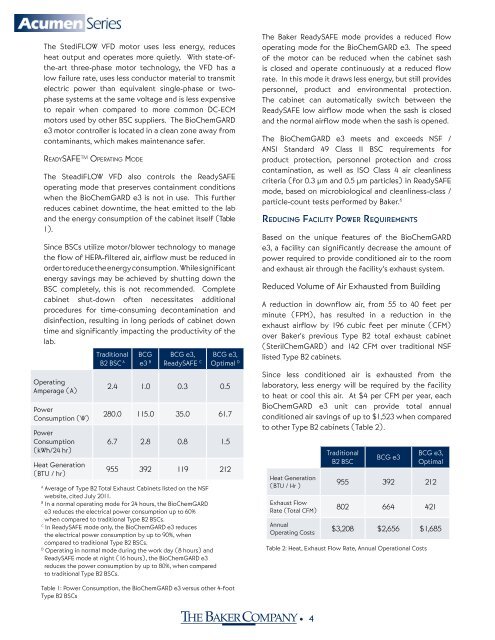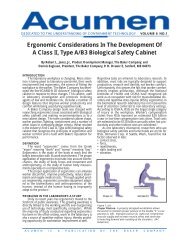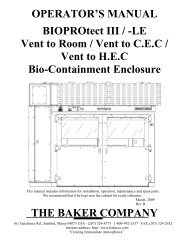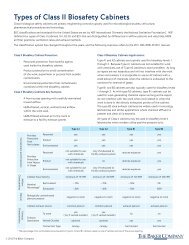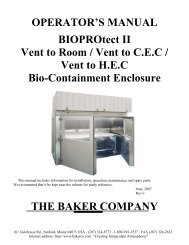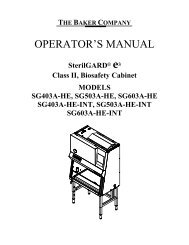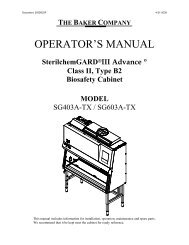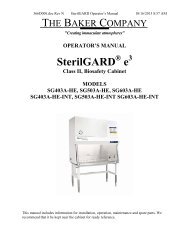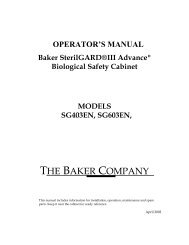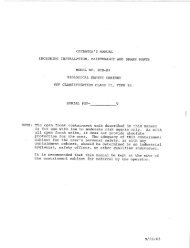Download the BioChemGARD white paper - The Baker Company Blog
Download the BioChemGARD white paper - The Baker Company Blog
Download the BioChemGARD white paper - The Baker Company Blog
You also want an ePaper? Increase the reach of your titles
YUMPU automatically turns print PDFs into web optimized ePapers that Google loves.
<strong>The</strong> StediFLOW VFD motor uses less energy, reduces<br />
heat output and operates more quietly. With state-of<strong>the</strong>-art<br />
three-phase motor technology, <strong>the</strong> VFD has a<br />
low failure rate, uses less conductor material to transmit<br />
electric power than equivalent single-phase or twophase<br />
systems at <strong>the</strong> same voltage and is less expensive<br />
to repair when compared to more common DC-ECM<br />
motors used by o<strong>the</strong>r BSC suppliers. <strong>The</strong> <strong>BioChemGARD</strong><br />
e3 motor controller is located in a clean zone away from<br />
contaminants, which makes maintenance safer.<br />
ReadySAFE Operating Mode<br />
<strong>The</strong> SteadiFLOW VFD also controls <strong>the</strong> ReadySAFE<br />
operating mode that preserves containment conditions<br />
when <strong>the</strong> <strong>BioChemGARD</strong> e3 is not in use. This fur<strong>the</strong>r<br />
reduces cabinet downtime, <strong>the</strong> heat emitted to <strong>the</strong> lab<br />
and <strong>the</strong> energy consumption of <strong>the</strong> cabinet itself (Table<br />
1).<br />
Since BSCs utilize motor/blower technology to manage<br />
<strong>the</strong> flow of HEPA-filtered air, airflow must be reduced in<br />
order to reduce <strong>the</strong> energy consumption. While significant<br />
energy savings may be achieved by shutting down <strong>the</strong><br />
BSC completely, this is not recommended. Complete<br />
cabinet shut-down often necessitates additional<br />
procedures for time-consuming decontamination and<br />
disinfection, resulting in long periods of cabinet down<br />
time and significantly impacting <strong>the</strong> productivity of <strong>the</strong><br />
lab.<br />
Operating<br />
Amperage (A)<br />
Power<br />
Consumption (W)<br />
Power<br />
Consumption<br />
(kWh/24 hr)<br />
Heat Generation<br />
(BTU / hr)<br />
Traditional<br />
B2 BSC A<br />
BCG BCG e3, BCG e3,<br />
e3 B ReadySAFE C Optimal D<br />
2.4 1.0 0.3 0.5<br />
280.0 115.0 35.0 61.7<br />
6.7 2.8 0.8 1.5<br />
955 392 119 212<br />
A<br />
Average of Type B2 Total Exhaust Cabinets listed on <strong>the</strong> NSF<br />
website, cited July 2011.<br />
B<br />
In a normal operating mode for 24 hours, <strong>the</strong> <strong>BioChemGARD</strong><br />
e3 reduces <strong>the</strong> electrical power consumption up to 60%<br />
when compared to traditional Type B2 BSCs.<br />
C<br />
In ReadySAFE mode only, <strong>the</strong> <strong>BioChemGARD</strong> e3 reduces<br />
<strong>the</strong> electrical power consumption by up to 90%, when<br />
compared to traditional Type B2 BSCs.<br />
D<br />
Operating in normal mode during <strong>the</strong> work day (8 hours) and<br />
ReadySAFE mode at night (16 hours), <strong>the</strong> <strong>BioChemGARD</strong> e3<br />
reduces <strong>the</strong> power consumption by up to 80%, when compared<br />
to traditional Type B2 BSCs.<br />
<strong>The</strong> <strong>Baker</strong> ReadySAFE mode provides a reduced flow<br />
operating mode for <strong>the</strong> <strong>BioChemGARD</strong> e3. <strong>The</strong> speed<br />
of <strong>the</strong> motor can be reduced when <strong>the</strong> cabinet sash<br />
is closed and operate continuously at a reduced flow<br />
rate. In this mode it draws less energy, but still provides<br />
personnel, product and environmental protection.<br />
<strong>The</strong> cabinet can automatically switch between <strong>the</strong><br />
ReadySAFE low airflow mode when <strong>the</strong> sash is closed<br />
and <strong>the</strong> normal airflow mode when <strong>the</strong> sash is opened.<br />
<strong>The</strong> <strong>BioChemGARD</strong> e3 meets and exceeds NSF /<br />
ANSI Standard 49 Class II BSC requirements for<br />
product protection, personnel protection and cross<br />
contamination, as well as ISO Class 4 air cleanliness<br />
criteria (for 0.3 µm and 0.5 µm particles) in ReadySAFE<br />
mode, based on microbiological and cleanliness-class /<br />
particle-count tests performed by <strong>Baker</strong>. 6<br />
Reducing Facility Power Requirements<br />
Based on <strong>the</strong> unique features of <strong>the</strong> <strong>BioChemGARD</strong><br />
e3, a facility can significantly decrease <strong>the</strong> amount of<br />
power required to provide conditioned air to <strong>the</strong> room<br />
and exhaust air through <strong>the</strong> facility’s exhaust system.<br />
Reduced Volume of Air Exhausted from Building<br />
A reduction in downflow air, from 55 to 40 feet per<br />
minute (FPM), has resulted in a reduction in <strong>the</strong><br />
exhaust airflow by 196 cubic feet per minute (CFM)<br />
over <strong>Baker</strong>’s previous Type B2 total exhaust cabinet<br />
(SterilChemGARD) and 142 CFM over traditional NSF<br />
listed Type B2 cabinets.<br />
Since less conditioned air is exhausted from <strong>the</strong><br />
laboratory, less energy will be required by <strong>the</strong> facility<br />
to heat or cool this air. At $4 per CFM per year, each<br />
<strong>BioChemGARD</strong> e3 unit can provide total annual<br />
conditioned air savings of up to $1,523 when compared<br />
to o<strong>the</strong>r Type B2 cabinets (Table 2).<br />
Heat Generation<br />
(BTU / Hr )<br />
Exhaust Flow<br />
Rate (Total CFM)<br />
Annual<br />
Operating Costs<br />
Traditional<br />
B2 BSC<br />
BCG e3<br />
BCG e3,<br />
Optimal<br />
955 392 212<br />
802 664 421<br />
$3,208 $2,656 $1,685<br />
Table 2: Heat, Exhaust Flow Rate, Annual Operational Costs<br />
Table 1: Power Consumption, <strong>the</strong> <strong>BioChemGARD</strong> e3 versus o<strong>the</strong>r 4-foot<br />
Type B2 BSCs<br />
• 4


